Bestiary |
Uwan
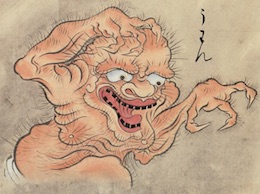
A body-less voice that scares abandoned Japanese homes and temples. Passers-by outside hear nothing, but the intruder's hearing is hit by a shrill scream.
Even though it is only an acoustic being, illustrators, such as Sawaki Suushi, have given him the appearance (and hence the body) for his purpose, so I can open this page of the Bestiary with an accompanying illustration from Suushi's Hyakkai-Zukan.
Illustration by Sawaki Sūshi (佐脇嵩之, Japanase, *1707, †1772)
(scanned from ISBN 978-4-336-04187-6.) [Public domain], via Wikimedia Commons
12.4.2019 (23.9.2018)
Hadwabl
She haunted in the woods near Horní Slavkov near Loket, a town in West Bohemia. Once upon a time, there was a castle in the forest, and its mistress hid her huge fortune in the dark forest. Later she began to watch it as a ghost. She was scaring away random as well as non-casual visitors. Her other appearance was the form of a little girl in red stockings, with a big key on red tape and a coffer at her feet.
17.5.2019 (25.4.2010)
Hýkavý Martin (Braying Martin)
A figure of a common Czech folktale, one of the misers who pushed the milestones at night. Most of them became fire spirits, but somebody ended up like Hýkavý Martin: wandering through the nights, screaming and halking on the back of the mockers. Martin, who haunted near Jankov, a village near Budweis, aside a usual ask: “Where do I give it,” brayed like a donkey. Past present in the previous sentence is absolutely fine because once someone has finally advised him (“Where you took it.”) and the spirit of the former local harpoon has been freed.
24.5.2019 (1.5.2010)
Ještědský duch
Ještědský duch (Jeschkengeist) is a genius loci of Ještěd Mountain in northern Bohemia. He used to be seen in the form of a great mountaineer with a hat and beard.
As the mountain is a place of many legends, Ještědský duch was not the only supernatural inhabitant of the region. The company read a number of revelations: elves, guarding gold and silver veins; a ghostly hunter, chasing a deer with a golden cross between antlers; occasional Wild Hunt; as well as annual Witches' Sabbath.
3.6.2019 (1.5.2010)
Zashiki-warashi
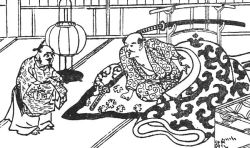
Even the Japanese employ household gnomes. Zashiki-warashi (zashiki-bokko) from Iwate Prefecture looks like a five-year-old kid with red cheeks and his presence brings good luck to the house. His leaving then means a leaving of luck, it is therefore better to tolerate his occasional childish pranks.
As usual, few people can see him (sometimes he leaves traces of his tiny feet in the ashes). Above all, they are children who, as we know, see a lot of things. However, he will never be seen by anyone who does not belong to the inhabitants of the house.
Illustration Ueda Akinari (上田秋成, Japanese, *1734, †1809) [Public domain], via Wikimedia Commons
19.6.2019 (14.3.2010)
Marishi-ten
Soldiers keep her picture under their helmets, though no one really knows how this Japanese goddess actually looks. Which does not prevent people from inventing it: She often has six hands, three heads (to see in all directions), and rides seven boars. She also has a sword, a bow, and arrows.
She was born from the first sunbeam; she is invisible, but she listens and when she hears her worshiper, she gives him courage and great strength.
1.7.2019 (21.12.2008)
Zámecký sedlák (Castle Farmer)
I have two pieces of news. The good one first.
There is a treasure hidden in Zámecký vrch near Česká Kamenice, a town in north Bohemia.
Now the worse part of the information.
On the same hill, the specter of a peasant farmer, a beardless old man in shorts, bright shoes, and a blue cloak with a fur collar appears. If you — if you go looking for that treasure — get in the way of the pale face of the Castle Farmer, you can expect something unpleasant to happen in the near future.
9.7.2019 (1.2. 2004)
Sântoaderi
Sântoaderi haunts in Romania. At first glance they resemble young men; at the second sight you will find that they are equipped with hooves. They appear in groups of seven, or — who would think — of nine. Wearing hoods on their heads. A nice conglomerate, especially when I add that when they appear, they sing and beat the drums, dancing and spreading diseases, especially rheumatism. Their main goal is girls, but these victims sometimes get the gift of beauty instead of illness. It only seems to me or is there a real connection with the Greek satyrs?
8.8.2019 (16.1.2011)
Huehuecoyótl
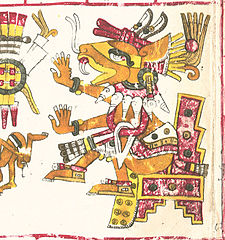
The “Ancient Coyote” is a truly ancient deity, even suspected of having served not only the Aztecs but their predecessors. Which is not surprising for the patron of the dance, music, and uninhibited sex. The Coyote is a well-known creature in the southwest of North America, acting in the role of Trickster, the later rulers of the Basin of Mexico came from somewhere north, so it is possible that seven tribes, which later put together a well-known empire, brought Huehuecoyótl from there.
Ilustration by UnknownUnknown author (This image was created with Adobe Photoshop.) [Public domain], via Wikimedia Commons
14.8.2019 (21.10.2018)
Hraničník (The Borderer)
A forest spirit that appears near Česká Třebová in east Bohemia. Unobtrusive, silent, wearing a gray suit, he suddenly materializes beside the traveler (or behind his back). He works especially in rainy weather and disappears as soon as it stops raining.
27.8.2019 (15.12.2008)
Grootslang
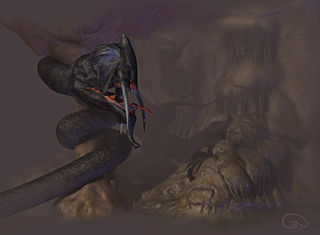
When the Gods made up the world and its inhabitants, they mistakenly gave one species a little more than they wanted. Huge power as well as high intelligence and ability to use them. So they had no choice but the creatures we know today under the name Grootslang, (which certainly cannot be their true name, because the beginning of the world was certainly not spoken in Afrikaans), to divide. To Elephants and Snakes. Whence we can deduce what those ancient beings looked like. Huge pachyderms with snake tails.
But how can we be so sure?
Not all grootslangs did not avoid the halving of appearance and abilities. One of them was said to have escaped. It hid somewhere in Richtersveld, a rocky desert area in the southwest of present-day South Africa. It liked the warm lake or river water but settled in a cave called Wonder Hole (otherwise called Bottomless Pit), and fed on the elephants it lured into it. It was said in the county that this Bottom Pit was connected to the sea sixty kilometers away and full of diamonds.
According to the legend from Benin, Grootslang´s precious stones collection came by simple blackmail – the monster chose them as a ransom for kidnapped travelers.
Grootslang by Jeff McArthur (Guategeek) (Own work) [CC BY-SA 3.0], via Wikimedia Commons
4.9.2019 (28.1.2018)
Tariaksuq
Shadow people the Inuit report about. They are no different from us. They live their shadow lives in shadow houses in the shadow country, just they are not visible. You can see their shadow, of course, but themselves only by killing them. If they are directly observed immediately flee to their shadow realm.
25.9.2019 (15.9.2019)
Dones d'aigua
Ladies, corresponding to ancient Greek nymphs. However, they live in a number of myths and legends of Catalonia. They are home to all places where clean water can be found. Fish from the waist down, but beautiful girls from the waist up with two excellent qualities – they guard the treasures and they're nice.
Some of these water mermaids dwell in caves or forests (which makes their Mediterranean origin more evident) and some have chosen the bird's lower body instead of a fish's tail.
2.10.2019 (11.4.2002)
Börries
Börries haunts in Dutch Friesland. If you meet a big black poodle with glowing eyes there, then know that it is a devil in disguise.
4.11.2019 (2.6.2019)
Alyp Chara Aat Mogojdoon
The English name of this Yakuts abasy was "Black wizard, noble dragon". Yes, I am talking in the past tense because this metal man-eating giant was part of the story of warrior Njurgun Bootur and as it goes, he did not survive until its end. The hero was helped by giant brother-in-law Chaan Ďargystaj, but judging by his foe it for sure was a fair fight.
As was said before, this giant was made of metal. This is very important but before I say why, let's look at his description because Alyp Chara Aat Mogojdoon is not of common appearance. Three heads, each with one eye and sharp teeth and six pairs of limbs. From the top, they looked like eagle's talons, swords, axes, spears, bear paws, and moose (or bull) hooves. With an opponent, this equipped it was hard but both friends managed it together. At first sight, it may resemble Heracles' cooperation with Iolaus and their fight against the Lernean hydra, when the hero was chopping off heads and his assistant helped by burning the stumps, so they do not regenerate. However, Yakuts slayers of monsters had it easier, because, with each beheading, one pair of limbs became paralyzed. The headless body ended up in a swamp, where it rusted.
5.12.2019 (12.12.2010)
Olentzero
Giants of Pyrenes once saw a shining cloud nearby a town known today as Lesaka. Well, they saw it, but they could not see it, the shine was too bright. Only one old and nearly blind man could inspect this heavenly spectacle. After he had done so, he announced that this was indeed a sign. And not some ordinary sign. Far away from there, on the east, the son of god was born. With him came a new world and new faith. The old man did not want to live in this new world and said it would be better to throw him from a cliff. The giants did as he asked and then followed him down. They did not intend to – they just fell down because they were pushing each other at the edge of a cliff. Only one remained. He visits Basque children at Christmas to give them gifts. Most of the time he arrives at night on Christmas Eve, however to some towns and villages he comes later, on the 27th of December. In Ermue children have to wait until the 31st. Spelling and pronunciation of his name differ, sometimes he is even known as Onenzaro or Orentzaro. This is everything for the first version, the mythological one, an adaptation of pre-Christian rituals.
Once upon a time, one fair-haired fairy found a newborn baby in a forest. She named him and because she knew that the best caretaker for a human would be other people, she gave it to an elderly childless couple. She gave him a name and raised him. (Choose according to your preferences.)
Whether he was raised by a fairy or a human, they raised him well, Olentzero grew into a strong man and became a coalman. He likes to carve toys from wood, carrying them in his coal bag and giving them out to children. Fire, however, became his doom. One winter, when a strong windstorm convinced everyone to stay home, this kind and strong man was returning home. He did not make it. When he saw a burning house and children trapped inside, he had to help them After carrying all the children to safety, the building collapsed and buried him in ruble. At that time a fairy returned to him, that fairy who once saved him as a baby. This time she gave him eternal life, so he could continue bringing joy, at least once a year. He is followed by elves clad in red called Prakagorri. Same elves that were there when the fairy saved Olentzero all that time ago. This is all for version number two, the more modern one.
Pedagogical addendum:
Last of the Pyrenese giants, a brute with a tendency to overeat and drink alcoholic beverages, roams the countryside wielding a sickle, that he used to freely cut through the throats of people that were not fasting before Christmas. Parents use this fact to scare children when they stay up too long and do not want to go to bed. In the streets of Ares, there is a masker with a sickle, in Berastegi parents add to this legend by throwing a sickle down the chimney.
3.1.2020 (23.12.2018)
Kudibal
Sources describe him as a big hairy man, a little devil with breath stronger than a windstorm, or a cow-like two-legged creature. You can choose one. This not-so-well-known Czech boggart was also called Kunibal, however, what was always the same was his occupation. Plucking of fowl feathers for making feather-bed and pillows was prohibited on certain days (mostly Saturdays, but somewhere even Thursdays) and he was making sure that this law is not broken. When some overly active woman worked on these days, Kudibal rushed into the room, blew away feathers, sometimes even sang a song, and then left. With advances in pillow-making technology, he disappeared completely.
8.1.2020 (17.8. 2003)
Skalní muž, Skalní duch and Skalník
T Three different Czech beings. The first one, Skalní muž (Rock Man) lives on a rock near Železný Brod (Eisenbrod). He leaves his den every evening, taking the form of a black dog. Returns after walking itself. The real appearance of this poor demon (at least in relation to other similar) can be seen only on St. Peter and Paul Day. Skalní muž accepts visitors around lunchtime. You have to only knock three times.
In comparison, Skalní duch (Rock Ghost) is a more dangerous creature. Workers in a quarry are very familiar with him. When they heard sounds of running horses or a windstorm, it was certain that there would be trouble.
Skalník (Rocky) takes the form of a three-headed firebreathing raven. He lives on a hill known as Škarmaň near Domažlice, but can be also seen in the Giant Mountains, where he likes to lead drunk people to celebrate New Year's Eve at the top of the hill and then push them to their deaths.
Other Skalníks can be found at the castle Svojanov, which is filled with supernatural creatures. There are six of them, the souls of six masons who built a secret passage from the castle and according to conspiracy rules then they were killed after finishing their job.
21.1.2020 (26. 10. 2003)
Kikimora
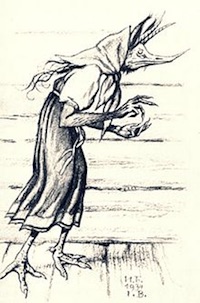
She has the word "mare" in her name, and it is seen as one in her area of origin – eastern Slavic countries. Kikimora (shishimora) is the first suspect people look at when someone has burdensome dreams and respiratory problems while sleeping. It is easy because she is a household creature; no one is saying that homesteaders have to always work fairly and for the minimum wage. As we know, some of them added in their contract concern of a master's soul; others just misbehave because they want to, and others, like kikimora, just have bad nature. Or reputation.
As a partner of Domovoi (who usually gives a good impression, however, both of them can cause a lot of damage to the yard, plucking feathers of poor hens, if the poultry is not guarded by their own protector, kuryniy bog) Kikimora used to be the dark side of homestead force, the side which educates by punishing. Later she started merging with her partner, which happens to creatures who are in the same field for a long time. But Domovoi’s wife usually is domavitchka, who is living under the floor and showing herself only when she is sought by stray children or lives the peaceful life of an old bachelor. Let's leave it to imps to organize their own personal lives as they wish.
Kikimoras originate either from forests — these are moving to Domovoi under the roof, or from swamps, these choose Lesoviks (spirits of woods) as their partners. The first group (on which we have more information, so we will just leave swamps partners of forest demons) live behind the oven, in the corner on the right from the door, or in the cellar. Their presence can be known by the sounds they make – but they usually sound like sneaking mice. However, it is not good if you hear one – they herald misfortune. Even worse is to see them spinning on the bench – that means certain death for the observer. Spinning, as one of the job, characteristics of women, is connected to this demon who takes the form of an old countrywoman with loose hair. It is important to secure your piece of work with a sign of the cross after dusk. If you do not do so, it will be all knotted in the morning. Same works for embroidering. Dirty dishes left behind can turn into broken shards. Kikimora does not do work for people, she just wants to make sure the work is done. This is what she does at night all the year, except near Novgorod, when she shows herself only around Christmas.
Kikimora by Ivan Jakovlevič Bilibin [Public domain], via Wikimedia Commons
6.2.2020 (29.5.2016)
Orco Mamman
The Mother of the Mountains is a supernatural manager of Argentine metal deposits, especially precious ones. The beautiful lady with long hair, who likes combs them often with a golden comb, focuses on the miners who dig the ore no matter what they left behind.
10.3.2020 (10.3.2019)
Napf-Hans, a.k.a. Jean de la Boliéta
Swiss-made goblin; the first name is for German-speaking inhabitants of this Alpine country, the second to those whose native language is French.
Was paid by a bowl of cream put onto a cowshed roof, and he keep an eye on the cattle. He was especially useful in bad weather when it was necessary to drive freely grazing cows safely into the stable.
7.4.2020 (18.7.2016)
Bogyňky
Slovak evil fairies. They live in streams and bogs. Swap newborn babies for sick and ugly ones. Sometimes and somewhere known as dženžebaby or indžibaby.
15.4.2020 (18.2.2002)
Turanna
The fairy Turanna is known amongst the Toscani as a guardian of people in love, however, her history is deeper. One of the ancestors of this being is Turan, the Etruscan goddess of love, beauty, and fertility. Winged, well dressed young maiden wearing jewelry (but later, under Greek influence, depicted naked). Her symbols are a swan, but also a goose or even a dove. She was a patron of one of the twelve Etruscan cities, Velch (Vulci). She is often accompanied by nymph Lasa (or group of nymphs Lasae, lesser fate deities, formed by others, for example, Evan or Alpanu).
Her name (also the name of the Etruscan month July) means Lady (or Dove, as stated by curators of Gallo-Romeins Museum in Tongeren, Belgium) and it comes from the ancient Greek word túrannos, meaning absolute ruler.
12.5.2020 (5.8.2018)
Kordula
She lived in the reeds by the Czech ponds, but she was not relative to water demons. From spring to autumn, Kordula looked out for victims from her lurking place; whoever wandered barefoot in the mud or puddles she cut the skin on his feet at night. Moravians knew her as Paní Hachla (Mrs. Hachla) or Sekavá bába (A Chopping Hag). In all cases, she used to be hired by parents, who tried to prevent kids from unpleasant experiences with cracked heels.
8.6.2020 (12.9.2002)
Pikulík
A teeny-tiny inch-tall imp from Slovakia. Much stronger than he looks. He brings luck to the owner, does chores and agricultural work. However, nothing is free. The ownership of this goblin is accompanied by a memento: the soul of the third owner belongs to the Devil. So if someone offers you that helper, you rather check his CV well.
4.7.2020 (17.7.2011)
Ogun
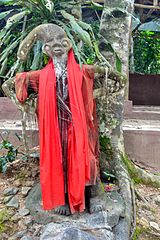
Every fourth day in a month, every Tuesday and Wednesday, and every twenty-ninth day of June belong to this voodoo warrior, master of battle, blood, and iron, Ogun. Sadly arguments resolved on the battlefield are usually the driving force of technological advancement, so one cannot be surprised that this loa is also the governor of technologies. Not only weapons but also everyday useful tools such as medical instruments, farming machines, and locomotives. He is the patron of physicians, soldiers, and even policemen. People without jobs refer to him. Thanks to his warrior fondness for blood, he is often summoned to heal the illness of this rare bodily fluid, however, for the same reason, it is not advised to ask for his help while possessing an open wound.
The best place where one can summon him are crossroads, ideally three-way crossroads, however, people give him tributes even on railroads. He does not belong only to voodoo confessors. His original African worshippers adopted him to other religions and cults. As a catholic equivalent, Ogun is Saint Joseph of voodoo, George of candomblé and Saint Peter of santeria, palo mayombe or lucumi.
In his homeland amongst the African Yoruban people, he is a husband of Oja and the first one who descended from heaven to earth. He showed himself disguised as a hunter named Tobe Ode. According to Dahomey, he was sent to our world to make it a place suitable for people, however, his work is not finished yet.
The statue of Ogun shot by Yeniajayiii [CC BY-SA 4.0], via Wikimedia Commons
10.8.2020 (7.4.2019)
Filomez
The younger sister (not always and not everywhere) of much more known loa Erzulia Freda. Voodoo goddess of water and pastel colors. While praying to her, one should offer her flowers of those hues. Her catholic equivalent is Saint Philomena. She brings financial success and sometimes (when she is considered Erzulia’s sister) even love.
24.8. 2020 (7.4.2019)
Klemezin
Haitian equivalent of Saint Clara of Assisi. Young beautiful lady who throwing around flowers. With her broom, she can sweep away misfortune from the worshipper’s house. While summoning her, one should lay around flowers and spray perfume. She can even visit people in their dreams and offer solutions to their problems. To achieve this, worshippers usually put a bowl with water, white flowers, and coconut milk under their beds. Her colors are white and light blue, and for that reason, all her tributes have these hues.
7.9. 2020 (7.4.2019)
Van Hunks
He was a pirate by trade, and he managed (which was quite unusual, unlike how adventurous books portray it) to amass substantial wealth and retire in Cape Town. He had his life secured, and he was duly proud, and with a pile of sins in the register, making him an ideal candidate for a curse.
One day this pensioned-off pirate ventures to a peak (because of the dramatic effect I will tell you its current name later) to enjoy a nice view of the peaceful surrounding area. He smoked a bit. Van Hunks was exceptionally proud of his smoking art. Mainly on the amount of smoke, he managed to inhale and exhale from his pipe. So he puffed when suddenly another visitor appeared, a mysterious man in a cape who challenged him to a smoking contest.
The seasoned sea dog accepted this challenge. He had all the aces in his sleeve and would probably win, would not it be for one little fact: no sinner can overcome the Devil (and now it's clear that this peak's name is Devil's Peak.). As soon as Van Hunks realized who his foe is, both contestants disappeared in a cloud of smoke.
This battle repeats every year. Then the famous Table Mountain is engulfed in a fog (known as a tablecloth), and if you visit South Africa at the right time, you can see it for yourself.
2.10.2020 (9.4.2011)
Micohlav
Although the ghouls are inhabitants of the Arabian deserts, they sometimes must go on holiday or teach a foreign student. How else to classify the ghost of a man named (or nicknamed) Micohlav, who began to haunt Žamberk, Bohemia, already at his funeral?
Later he was raising from his grave, dug other corpses, and ate their flesh. It was radical but necessary to exhume the body and took Micohlav to the crossroad (which is the verified mystic place for dealing with vampires and similar unwanted creatures), where the executioner, as entrusting person, beheaded him.
4.11. 2020 (3.9.2016)
Bilmischschnitter
She was destroying a crop in fields around Bohemian Forest town Železná Ruda but the damages that she made were not so big as the damages caused by other vermins. Nowadays should paranormalists maybe gladly accept her, although Bilmischschnitter cut signs of crosses in the field instead of circles.
3.12. 2020 (14.6.2020)